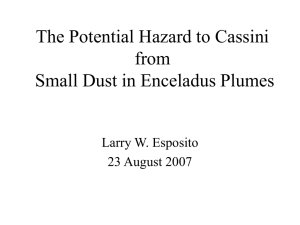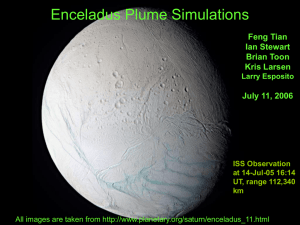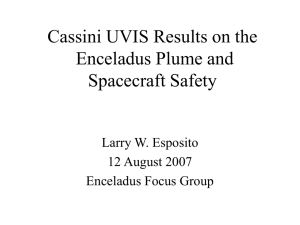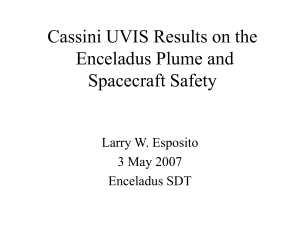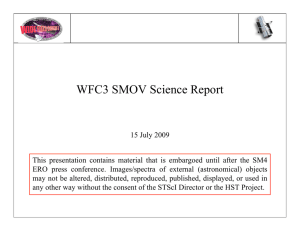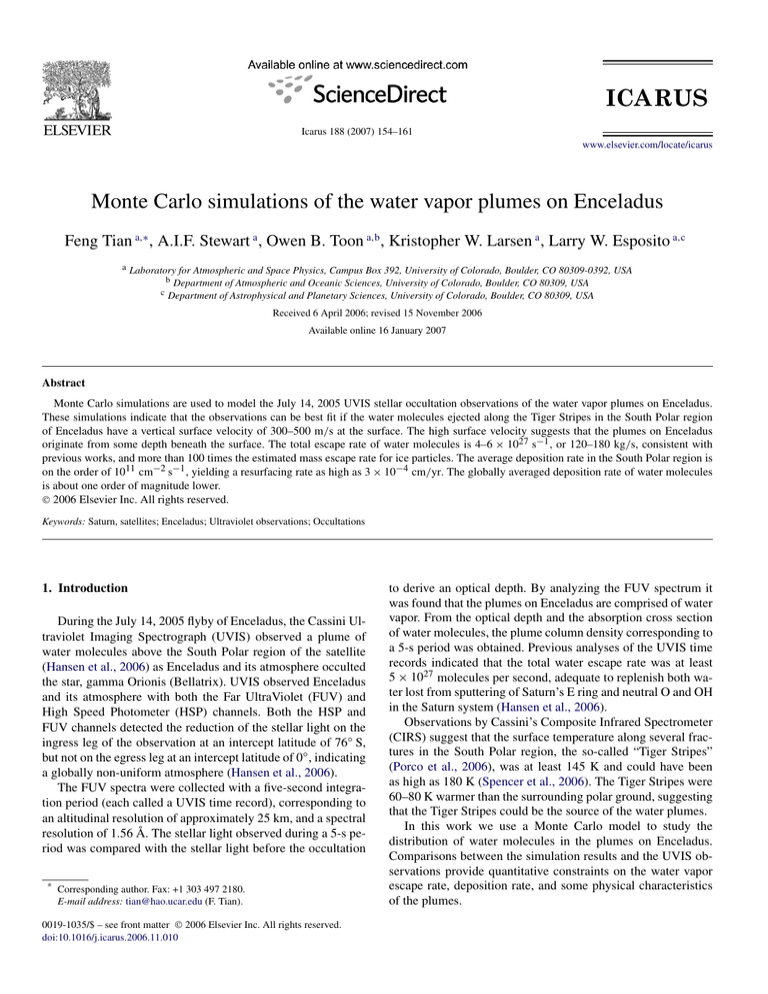
Icarus 188 (2007) 154–161
www.elsevier.com/locate/icarus
Monte Carlo simulations of the water vapor plumes on Enceladus
Feng Tian a,∗ , A.I.F. Stewart a , Owen B. Toon a,b , Kristopher W. Larsen a , Larry W. Esposito a,c
a Laboratory for Atmospheric and Space Physics, Campus Box 392, University of Colorado, Boulder, CO 80309-0392, USA
b Department of Atmospheric and Oceanic Sciences, University of Colorado, Boulder, CO 80309, USA
c Department of Astrophysical and Planetary Sciences, University of Colorado, Boulder, CO 80309, USA
Received 6 April 2006; revised 15 November 2006
Available online 16 January 2007
Abstract
Monte Carlo simulations are used to model the July 14, 2005 UVIS stellar occultation observations of the water vapor plumes on Enceladus.
These simulations indicate that the observations can be best fit if the water molecules ejected along the Tiger Stripes in the South Polar region
of Enceladus have a vertical surface velocity of 300–500 m/s at the surface. The high surface velocity suggests that the plumes on Enceladus
originate from some depth beneath the surface. The total escape rate of water molecules is 4–6 × 1027 s−1 , or 120–180 kg/s, consistent with
previous works, and more than 100 times the estimated mass escape rate for ice particles. The average deposition rate in the South Polar region is
on the order of 1011 cm−2 s−1 , yielding a resurfacing rate as high as 3 × 10−4 cm/yr. The globally averaged deposition rate of water molecules
is about one order of magnitude lower.
© 2006 Elsevier Inc. All rights reserved.
Keywords: Saturn, satellites; Enceladus; Ultraviolet observations; Occultations
1. Introduction
During the July 14, 2005 flyby of Enceladus, the Cassini Ultraviolet Imaging Spectrograph (UVIS) observed a plume of
water molecules above the South Polar region of the satellite
(Hansen et al., 2006) as Enceladus and its atmosphere occulted
the star, gamma Orionis (Bellatrix). UVIS observed Enceladus
and its atmosphere with both the Far UltraViolet (FUV) and
High Speed Photometer (HSP) channels. Both the HSP and
FUV channels detected the reduction of the stellar light on the
ingress leg of the observation at an intercept latitude of 76◦ S,
but not on the egress leg at an intercept latitude of 0◦ , indicating
a globally non-uniform atmosphere (Hansen et al., 2006).
The FUV spectra were collected with a five-second integration period (each called a UVIS time record), corresponding to
an altitudinal resolution of approximately 25 km, and a spectral
resolution of 1.56 Å. The stellar light observed during a 5-s period was compared with the stellar light before the occultation
* Corresponding author. Fax: +1 303 497 2180.
E-mail address: tian@hao.ucar.edu (F. Tian).
0019-1035/$ – see front matter © 2006 Elsevier Inc. All rights reserved.
doi:10.1016/j.icarus.2006.11.010
to derive an optical depth. By analyzing the FUV spectrum it
was found that the plumes on Enceladus are comprised of water
vapor. From the optical depth and the absorption cross section
of water molecules, the plume column density corresponding to
a 5-s period was obtained. Previous analyses of the UVIS time
records indicated that the total water escape rate was at least
5 × 1027 molecules per second, adequate to replenish both water lost from sputtering of Saturn’s E ring and neutral O and OH
in the Saturn system (Hansen et al., 2006).
Observations by Cassini’s Composite Infrared Spectrometer
(CIRS) suggest that the surface temperature along several fractures in the South Polar region, the so-called “Tiger Stripes”
(Porco et al., 2006), was at least 145 K and could have been
as high as 180 K (Spencer et al., 2006). The Tiger Stripes were
60–80 K warmer than the surrounding polar ground, suggesting
that the Tiger Stripes could be the source of the water plumes.
In this work we use a Monte Carlo model to study the
distribution of water molecules in the plumes on Enceladus.
Comparisons between the simulation results and the UVIS observations provide quantitative constraints on the water vapor
escape rate, deposition rate, and some physical characteristics
of the plumes.
Simulations of the water vapor plumes on Enceladus
2. Model description
We constructed a Monte Carlo model which tracks 10,000
test particles from their point source at the surface into space.
The initial three-dimensional velocity of each particle contains
two components: a velocity (Vz ) which is perpendicular to the
surface, and a thermal velocity (Vth ) which is isotropic in the
upward hemisphere. The direction and speed of the thermal velocity of each particle is chosen randomly but the ensemble
moves isotropically at a speed which satisfies a Boltzmann distribution for a temperature Tth . The model uses a fixed time step
t0 and tracks the trajectories of all particles under the influence
of gravity and collisions. All particles reaching 4 satellite radii
(1000 km) distance or returning to the surface are replaced with
particles from the source to maintain the total number of test
particles in the model domain.
The probability distribution of path lengths for collisions
between atmospheric particles is p(λ) ∝ exp(−λ/λ0 ), where
λ0 = 1/(σ · n) is the collision mean free path, σ is the collisional cross section of water molecules (10−15 cm2 ), and n is
the water molecule number density. Thus we generate the free
path lengths with the distribution: λ = −λ0 ln(r), where r is a
random number between 0 and 1. Because density decreases
with altitude, the mean free path and the free path lengths have
their smallest values near the surface. The probability of collisions is highest near the surface. We chose the fixed time step
t0 so that on average no more than one collision occurs for each
particle within each time step near the surface. For example,
t0 = 2 s when n0 = 1010 cm−3 and Vz = 500 m/s. If the time
needed for a test particle to travel its free path length is smaller
than t0 , this particular particle experiences one collision within
that time step. Then the location where the collision occurs is
determined, the velocity of the particle is reset by choosing new
random values following a Boltzmann distribution for Vth , and
the new velocity is used to find the location of the particle at
the end of that time step. The presence of large ice particles
is ignored. Although the possibility is small, the occurrence of
multiple collisions within t0 is considered in the model.
To calculate the probability of collisions, an important modeling factor is the spatial distribution of the density of water
molecules in the plumes. Although the model self-consistently
solves for this density, it is numerically efficient to make an initial guess of the density for use in the collision calculations.
This guess is then confirmed after the calculations are done.
Based on the UVIS stellar occultation observations, the maximum column density of the plume (∼1.5 × 1016 cm−2 ) occurs
at UVIS time record number 33 (the associated altitude ranges
from 9 to 33 km). A path length of 80 km is taken in Hansen et
al. (2006). The corresponding number density of the plume is
∼2 × 109 cm−3 . Considering the uncertainty in the path length
of the high density region, the number density of the plume at
this location is in the range 108 –109 cm−3 at ∼20 km altitude.
As a first approximation to the spatial distribution of the
density in the plume, we assume that the ratio between the expansion of the plume in the horizontal direction and the vertical
height of the plume is proportional to the ratio Vth /(Vz + Vth ),
Vth ∼ 400 m/s for water molecules at 180 K. We also assume
155
that the density within the expanding plume is constant across
the width of the plume, while the density beyond the horizontal edge of the plume is negligible. Under these simplifications,
the number density distribution in the plume can be described as
n(z) = n0 · (1 + (z/w)/(1 + Vz /Vth ))−2 , where z is the altitude
measured from the surface, and w is the half-width or radius
of the plume on the surface. According to the measurements
of the Cassini Imaging Science Subsystem (ISS), the average
half-width of the Tiger Stripes is ∼1 km (Porco et al., 2006).
If the vertical velocity is in the same order of magnitude as the
thermal velocity, the surface density, n0 , is 1010 –1011 cm−3 ,
given the density discussed above which is assumed to occur at
∼20 km. We use this simple density distribution in the model
to compute the collision frequency for each test particle at each
time step or after each collision and check the consistency using
the modeling results.
The total number of time steps included in each simulation depends on when the simulation reaches steady state. The
steady state is reached when the column density distributions in
two simulation results which are separated by 10,000 time steps
are the same to within 5%. After the steady state is reached,
we continue the simulation for 100,000 time steps and obtain
10 samples during that period of time for final analysis. All 10
samples are averaged to calculate the spatial distributions of water molecules ejected from one point source.
In Figs. 1a and 1b the density distributions used in the
model to compute collision rates are compared with those resulting from the simulations. We use the model distributions
along the core of the plumes. Although the number densities in
the simulation results show significant scatter around the predicted trend, the general trends of the modeled density curves
agree well with the assumptions—the model is self-consistent.
We find that the percentage of test particles which experienced
collisions is ∼6% for n0 = 1011 cm−3 cases and ∼0.6% for
n0 = 1010 cm−3 cases. The effect of collisions is not important
in these low surface density cases, which reduces the dependence of the simulation results on the number density assumption.
Fig. 2 shows the horizontal column density distributions of
the plume from one single point source under different surface
vertical velocity assumptions. Contour levels 1 and 0.1 represent actual column densities of 1 × 1017 and 1 × 1016 cm−2 ,
respectively. A given column density occurs at a higher altitude and slightly closer to the core horizontally in the 500 m/s
plume than in the 300 m/s plume. Fig. 2 shows that at altitudes
>10 km, the horizontal width of the plume at the 0.1 level is
greater than 40 km.
To compare the model-predicted column densities with the
UVIS observations, a scaling factor, which tells us how many
water molecules are represented by one test particle, is needed.
The scaling factor is chosen so that the predicted column density at UVIS time record 33 is the same as the corresponding UVIS observation. By counting the number of the test
particles moving out of the outer boundary of the model (4
Enceladus radii) and multiplying the number of the escaped
test particles with the scaling factor, the total escape rate can
be obtained. Because n0 and Vz are fixed for each simula-
156
F. Tian et al. / Icarus 188 (2007) 154–161
Fig. 1. Comparison between the density distributions of one point source from the simulation results and those assumed in the model.
Fig. 2. Normalized horizontal column density distributions for one point source in different vertical velocity cases. Contour levels 1 and 0.1 represent actual column
densities of 1 × 1017 and 1 × 1016 cm−2 , respectively.
Simulations of the water vapor plumes on Enceladus
157
Table 1
Geometric parameters for the Bellatrix occultation of Enceladus’ plumes
UVIS time
record
Mid-point
time (UTC)
Time to CA
(s)
Distance from
South Pole (km)
Spacecraft
altitude (km)
Ray height
altitude (km)
18
19
20
21
22
23
24
25
26
27
28
29
30
31
32
33
34
19:53:35
19:53:40
19:53:45
19:53:50
19:53:55
19:54:00
19:54:05
19:54:10
19:54:15
19:54:20
19:54:25
19:54:30
19:54:35
19:54:40
19:54:45
19:54:50
19:54:55
−105
−100
−95
−90
−85
−80
−75
−70
−65
−60
−55
−50
−45
−40
−35
−30
−25
756
720
685
650
616
583
551
520
491
464
439
416
396
380
367
359
355
702
665
629
594
559
524
490
457
425
394
363
334
307
281
257
235
216
564
525
486
447
408
370
332
294
257
220
184
149
114
81
50
21
−5
Notes. All parameters are calculated for the mid-point of the record integration. The closest approach (altitude 173 km) occurs at UTC 19:55:20, corresponding to
UVIS time record 39. Time to CA is the time between the mid-point time of the UVIS time records to the closest approach (CA). Ray height altitude (also known
as impact parameter) is the minimum distance between the surface of Enceladus and the instrument’s line-of-sight vector.
tion, the total surface area of the plumes can be determined
from the total escape rate. Essentially the scaling factor, the escape rate, and the total surface area are directly linked to each
other.
After computing the steady state for one source, the distribution of water molecules coming out of the Tiger Stripes is
obtained by summing 17 identical sources uniformly placed
along the four Tiger Stripes (stripe s2 is longer than the other
three stripes and has one more source than the others). When
17 sources are uniformly placed along the Tiger Stripes, the
average distance between adjacent sources along one stripe is
∼20 km. Thus the plumes from adjacent sources have merged
together to contribute to the water plumes observed by Cassini
UVIS. Therefore, increasing the number of point sources along
the Tiger Stripes from 17 to 30, while maintaining the total flux
from the surface (or the total escape rate) constant, only reduces
the surface area of each point source and does not affect the
simulation results.
The actual sources may be non-uniform in emission rate,
spatial locations, pointing directions, and time. Indeed the ISS
observations of the plumes on Enceladus (Porco et al., 2006)
seem to indicate a non-uniform distribution of the plumes.
Since the density distribution in the plume is affected by both
horizontal and vertical distance from the source, the effect of a
non-uniform source distribution along the Tiger Stripes is difficult to evaluate without knowing the relevant parameters. The
uniform distribution should be considered as a first approximation. Table 1 provides some geometric parameters of the Cassini
spacecraft during the stellar occultation observations. The approximate positions of the Tiger Stripes, the ground track of
Cassini spacecraft during the UVIS stellar occultation, and the
UVIS lines of sight are presented in Fig. 3.
3. Simulation results and discussions
We calculate the water molecule column densities along the
lines of sight during the UVIS observations of the stellar occultation and compare these simulated column densities with the
Cassini UVIS data in Fig. 4. As discussed above the model assumes that there are 17 identical sources uniformly distributed
along the four Tiger stripes. The UVIS data in Fig. 4 are noisy
for UVIS time record numbers lower than about 26 because
the plume density is low at those locations. Hence the primary
feature that determines the goodness of fit is the ability of the
model to match the slope from UVIS time record 26 to 33.
Figs. 4a and 4b show that Vz is required to be in the range
between 300 and 500 m/s to generate column densities in good
agreement with the UVIS data. If the plume has a zero Vz (sublimation from the surface) as the dash-dotted lines show, the
column density from the simulations declines more rapidly with
declining record number (increasing altitude) than observed by
the Cassini UVIS. This rapid decline is caused by the horizontal expansion of the water plume near the surface in the low Vz
cases, which leads to a large count for the UVIS time records 33
and 32, but fewer molecules reaching high altitudes corresponding to smaller UVIS time record numbers. If the plume has Vz
greater than the best fit velocities (for instance 700 or 1000 m/s,
shown as the dotted lines in Figs. 4a and 4b), the column density
curves flatten near UVIS time record number 32 because too
many molecules reach higher altitudes (lower record numbers).
Other simulation results (not shown) indicate that the model’s
agreement with the data is not sensitive to surface temperature
variation from 180 to 140 K.
The total water molecule escape rate, which is proportional to the scaling factor that shifts the predicted column
density curves up and down in Figs. 4a and 4b, needs to be
4–6 × 1027 s−1 in order to match the UVIS observations at time
158
F. Tian et al. / Icarus 188 (2007) 154–161
Fig. 3. The solid linear features mark the positions of the Tiger Stripes in the South Polar region of Enceladus. The stripes are numbered s1 to s4. The dotted lines
represent the lines of sight of the UVIS stellar occultation observations on July 14, 2005. The rightmost line of sight is for UVIS time record #33. The dashed curve
and the asterisks represent the footprints of Cassini spacecraft. The diamonds represent the positions where the distances between the lines of sight and the surface
of the satellite are the smallest.
record 33. This escape rate is almost identical to the lower
limit on the escape rate suggested by Hansen et al. (2006).
Jurac et al. (2002) used the OH cloud morphology in the Saturn system to predict that there was a ‘missing’ source of water
at the orbit of Enceladus, ∼3 × 1027 molecules s−1 . The estimate on the source rate has been lifted to ∼1028 molecules s−1
in newer studies (Jurac and Richardson, 2005). Hansen et al.
(2006) pointed out that the total water escape rate from Enceladus is adequate to replenish both Saturn’s E ring and neutral
O and OH in the Saturn system. Recently Johnson et al. (2006)
studied how water and OH molecules ejected from the South
Pole of Enceladus distribute in the Saturn system with an average source rate of 5×1027 molecules s−1 and suggested that the
plumes on Enceladus be indirect sources of the observed OH
torus. Our simulations support the findings in previous works.
The corresponding mass loss rate is 120–180 kg/s, more than
three orders of magnitude greater than the ice particle mass
escape rate (0.04 kg/s) deduced from the ISS measurements
(Porco et al., 2006) and more than two orders magnitude greater
than the ice particle mass escape rate (0.2–1 kg/s) deduced
from the Cassini Cosmic Dust Analyzer (CDA) measurements
(Spahn et al., 2006). Porco et al. (2006) show that the mean velocity of the ice particles is ∼60 m/s, much smaller than the
escape velocity of Enceladus (∼235 m/s). In addition to this,
the total mass of ice particles ejected from the plumes on Enceladus, ∼4 kg/s according to Porco et al. (2006), is smaller than
the total ejected mass of water vapor by more than one order of
magnitude.
Our simulation results suggest that all four stripes contribute
almost equally to the observed water vapor plumes except for
UVIS time record 33, at which the contributions from s2 and
s3 are about 60% of the total, and s1 and s4 about 40%. Contribution from s1 for UVIS time record 33 is small because the
UVIS lines of sight penetrates the plumes from s1 at high altitudes, where the densities in the plumes are low. The line of
sight for UVIS time record 33 is close to one end of stripe 4,
which is why stripe 4 contributes less than stripe s3 does for
UVIS time record 33. This is consistent with the approximate
positions of the stripes and the lines of sight during the UVIS
stellar occultation observations shown in Fig. 3.
From the escape rate, the surface number density, and the
vertical surface velocity, we can determine the total area of
the plumes on the surface of the satellite. The area is 120–
130 km2 in the n0 = 1011 cm−3 case and 1200–1300 km2 in
the n0 = 1010 cm−3 case. According to the Cassini ISS measurements, the average width of the Tiger Stripes is ∼2 km and
the total length of the Tiger Stripes is ∼500 km (Porco et al.,
2006). Thus our simulation results suggest that approximately
10% of the Tiger Stripe area is venting actively if surface density is 1011 cm−3 while all the Tiger Stripe area is venting in
the n0 = 1010 cm−3 case. A much greater surface density will
dramatically change the shape of the plume because of the increasingly significant effect of collisions and thus will not fit
Simulations of the water vapor plumes on Enceladus
159
Fig. 4. Comparison between the UVIS data (+ symbols) and the simulation results. Time to CA is taken from Table 1.
well with the UVIS stellar occultation measurements unless
the surface vertical velocity is significantly higher (>Mach 2).
With the same escape rate, a greater surface density and a higher
surface velocity lead to a narrower source region on the surface. Due to our limited knowledge of the vents, a combination
of both concentrated sources (with greater density and higher
velocity) and extended sources (with lower density and lower
velocity) cannot be ruled out. We have simply assumed all the
sources are identical for the sake of simplicity.
The simulation results show that water molecules must be
ejected from the Tiger Stripes in the South Polar region of
Enceladus at high vertical velocities (1.5 to 2 times the escape
velocity of Enceladus, or higher if the surface number density is
much greater than 1012 cm−3 )—an indication that the sources
of the plumes involve venting from some depth below the surface rather than sublimation from the surface itself (in which
case the vertical velocity should be zero). The high vertical velocity required to explain the UVIS data is consistent with the
conclusion obtained from CIRS data analysis—that the heat is
transported to the surface by advection of warm vapor rather
than by conduction through surface materials (Spencer et al.,
2006). The saturated vapor pressure of ice at 180 K is ∼0.01 Pa
(Marti and Mauersberger, 1993). Assuming that the vapor in
contact with the ice is at the same temperature as the ice, the vapor number density should be in the order of 1012 cm−3 . Thus
our inferred surface density 1010 –1011 cm−3 can be supplied
by ice at 180 K. The thermal velocity of water molecules at
180 K is ∼400 m/s. If source of the plumes is exposed within
a relatively narrow region such as a deep canyon, the molecules
will be focused upwards by collisions with the walls, yielding
the directed velocities that we find here. Porco et al. (2006) argued that the source of the ice particles observed by the Cassini
ISS should be subsurface boiling liquid at temperature 273 K
or higher. At 273 K the thermal velocity of water molecules is
∼500 m/s. The ISS findings do not contradict our basic result
that Vz = 300–500 m/s. The saturated vapor density over ice
or liquid water at 273 K is about 2 × 1017 cm−3 and the density just above the pores/cracks would be of the same order. To
be consistent with the present analysis (total escape rate and
surface velocity), such a high temperature would imply venting
through very narrow pores or cracks—1 cm if the effective
length is 500 km. This is because F = n ∗ u ∗ L ∗ d, where F is
the escape rate, n is the density, u is the velocity, L is the effective length, and d is the width of the cracks. If n is as large as
1 × 1017 cm−3 and other parameters (F, u, L) remain the same
values as discussed in this paper, then d must be 1 cm. On
the other hand, if the source temperature is 180 K, the width
of the cracks can be as wide as 200 m. The temperature of the
source, which is to be determined by future studies, can place
important constraints on the vent sizes and/or shapes.
By tracking water molecules returning to the surface of
Enceladus, we found that the total mass deposition rate is 1.3–
2.8 kg/s (lowest and highest values from the simulations with
Vz = 300–500 m/s), about two orders of magnitude smaller
160
F. Tian et al. / Icarus 188 (2007) 154–161
than the total escape rate. Most of the water molecules ejected
from the plumes on Enceladus escape from the satellite. The
globally averaged deposition rate of water molecules originating from the plumes on Enceladus is (6–12) × 109 cm−2 s−1 ,
comparable to the estimates on the water molecule sputtering
rates on Enceladus (Jurac et al., 2001; Shi et al., 1995). The
deposition rate in the South Polar region (latitude >75◦ ) is
(0.8–3) × 1011 cm−2 s−1 , one order of magnitude higher than
the global value. It is possible that in the South Polar region the
surface of Enceladus is in a state of net accumulation instead of
net erosion. Approximately 35–50% of all water molecules returning to the surface are deposited in the South Polar region.
The resurfacing rate is 8 × 10−5 –3 × 10−4 cm/yr in the South
Polar region and 6 × 10−6 –1 × 10−5 cm/yr globally. This high
resurfacing rate may help to explain the high albedo in between
the Tiger Stripes observed by Cassini ISS (Porco et al., 2006).
The Cassini Ion and Neutral Mass Spectrometer (INMS) observed water molecules during the July 14 flyby. Analysis of
the INMS data suggests that the water source rate from the
plumes on Enceladus is highly variable, between 1.5 × 1026 and
3 × 1027 s−1 (Waite et al., 2006). The lower limit fits well with
the INMS observations before −30 s to CA while the higher
limit fits well with the INMS data collected during the egress
times larger than 200 s after CA. Note that the high end estimate
of Waite et al. (2006) is almost the same as the water escape rate
from our analysis. We find that with a water vapor source rate
of 5 × 1027 s−1 , the water number densities at the trajectory of
Cassini between −100 s prior to the closest approach (CA) and
the CA are greater than 106 cm−3 . These densities are more
than one order of magnitude greater than the INMS measurements (between 104 and 105 cm−3 ) at the corresponding locations (Waite et al., 2006). If we reduce the water vapor source
rate to 1 × 1026 s−1 , the water number densities derived from
the simulations are of the same order of magnitude as those in
Waite et al. (2006). Because the minimum distance between the
Cassini trajectory and the South Pole of Enceladus is 355 km
(∼25 s to CA), the small water vapor source rate satisfying the
INMS measurements (1 × 1026 s−1 ) and the large water vapor
source rate satisfying the UVIS measurements (4–6 × 1027 s−1 )
are not mutually exclusive. Because it takes the water molecules ejected from the plumes in the South Pole region more
than 10 min to cover 350 km distance assuming a mean velocity of 500 m/s, it is possible that the UVIS observed the starting
phase of an ejection event on Enceladus whose plumes had not
reached the Cassini trajectory when the INMS took its measurements. This time variability of the plumes on Enceladus is
consistent with the suggestion by Waite et al. (2006) that the
water source rate from the plumes on Enceladus is highly variable. Other possible explanations include spatial variability of
the plumes (locations and/or pointing directions), or unknown
mechanisms to remove water molecules between the South Pole
and the trajectory of Cassini.
4. Summary
Monte Carlo simulations are used to model the July 14, 2005
UVIS stellar occultation observations of the water vapor plumes
on Enceladus. These simulations indicate that the observations
can be best fit if the water molecules ejected along the Tiger
Stripes in the South Polar region of Enceladus have a vertical surface velocity of 300–500 m/s at the surface. The high
surface velocity suggests that the plumes on Enceladus originate from some depth beneath the surface so that the horizontal
velocity component of the thermal motion is suppressed by collisions with the walls of a canyon, valley or other obstacle.
The total escape rate of water molecules is 4–6 × 1027 water
molecules per second (120–180 kg/s), consistent with previous works (Jurac et al., 2002; Jurac and Richardson, 2005;
Hansen et al., 2006; Johnson et al., 2006). This water vapor
escape rate is two and three orders of magnitude higher than
the ice particle escape rates inferred by Spahn et al. (2006) and
Porco et al. (2006), respectively. The mass flux of vapor out of
the source region is about 10 times greater than the ice mass
flux (most of which does not escape) derived by Porco et al.
(2006). The average deposition rate in the South Polar region
is on the order of 1011 cm−2 s−1 . The globally averaged deposition rate of water molecules is about one order of magnitude
lower. The resurfacing rate in the South Polar region can be as
high as 3 × 10−4 cm/yr. Comparisons between the simulation
results and the INMS measurements suggests that the water vapor source rate from the plumes on Enceladus may be highly
variable, consistent with the suggestions in Waite et al. (2006).
Acknowledgments
The authors thank two anonymous reviewers, whose comments and suggestions have helped to improve the paper significantly. The authors thank A.P. Ingersoll, R.T. Pappalardo,
C.C. Porco, and J. Schmidt for their careful readings of the manuscript and their helpful suggestions. This work was supported
by Planetary Atmospheres Grant NNGO5GA53G and by the
Cassini project.
References
Hansen, C.J., Esposito, L.W., Stewart, A.I.F., Colwell, J., Hendrix, A., Pryor,
Shemansky, D., West, R., 2006. Cassini Ultra-Violet Imaging Spectrograph
(UVIS) investigation of Enceladus’ water vapor plume. Science 311, 1422–
1425.
Johnson, R.E., Smith, H.T., Tucker, O.J., Liu, M., Burger, M.H., Sittler, E.C.,
Tokar, R.L., 2006. The Enceladus and OH Tori at Saturn. Astrophys. J. 644,
L137–L139.
Jurac, S., Johnson, R.E., Richardson, J.D., Paranicas, C., 2001. Satellite sputtering in Saturn’s magnetosphere. Planet. Space Sci. 49, 319–326.
Jurac, S., McGrath, M.A., Johnson, R.E., Richardson, J.D., Vasyliunas, V.M.,
Eviatar, A., 2002. Saturn: Search for a missing water source. Geophys. Res.
Lett. 29, 2172–2175.
Jurac, S., Richardson, J.D., 2005. A self-consistent model of plasma and
neutrals at Saturn: Neutral cloud morphology. J. Gephys. Res. 110,
doi:10.1029/2004JA010635. A09220.
Marti, W.J., Mauersberger, K., 1993. A survey and new measurements of ice
vapor pressure at temperatures between 170 and 250 K. Geophys. Res.
Lett. 20, 363–366.
Porco, C.C., and 25 colleagues, 2006. Cassini observes the active south pole of
Enceladus. Science 311, 1393–1401.
Shi, M., Baragiola, R.A., Grosjean, D.E., Johnson, R.E., Jurac, S., Schou, J.,
1995. Sputtering of water ice surfaces and the production of extended neutral atmospheres. J. Geophys. Res. 100, 26387–26396.
Simulations of the water vapor plumes on Enceladus
Spahn, F., and 16 colleagues, 2006. Cassini dust measurements at Enceladus and implications for the origin of the E ring. Science 311, 1416–
1418.
Spencer, J.R., Pearl, J.C., Segura, M., Flasar, F.M., Mamoutkine, A., Romani,
P., Buratti, B.J., Hendrix, A.R., Spilker, L.J., Lopes, R.M.C., 2006. Cassini
161
encounters Enceladus: Background, and discovery of a South Polar hot spot.
Science 311, 1401–1405.
Waite Jr., J.H., and 14 colleagues, 2006. Cassini Ion and Neutral Mass Spectrometer: Enceladus plume composition and structure. Science 311, 1419–
1422.

